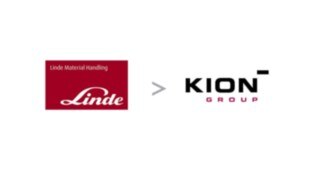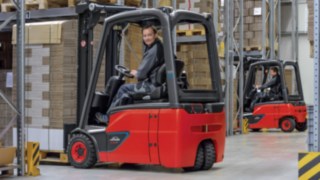
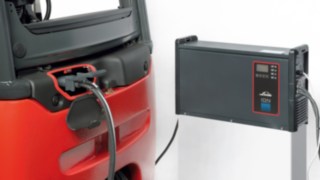
Fleet management using connect: Productivity, uptime, safety: up – costs: down
5 Mar 2015
Start of sales for connect: fleet management solution from Linde Material Handling
After a successful test phase, Linde Material Handling is launching its new connect: fleet management solution on the market. It was presented at last year’s World of Material Handling customer event. connect: provides fleet managers with transparent data relating to drivers and vehicles, their usage and place of use. The analysis of this data provides greater safety of in-house traffic, higher availability of equipment through optimized service and less damage, as well as a more efficient use of vehicles – fleet operation becomes more economical in every respect.
“Functions that can be flexibly combined, intuitive software that is fully scalable depending on the number of users and fleet size, plus powerful servers and simple modules for local infrastructure, as well as data mining and reporting tools and attractive pricing models – with connect: we can configure solutions that are ideally tuned to the customer’s individual requirements and optimally bring to bear the potential of any fleet,” says Maik Manthey, who is in charge of the Linde Connected Solutions business unit in his capacity as Vice President New Business & Products. “During the test phase, we received very positive and constructive feedback from our pilot partners and directly translated this into corresponding product optimizations. So we’re launching a matured solution.”
Content pilot customers
The hardware and software components of the modular connect: product family were tested by eight pilot customers in a total of 800 vehicles. One of these pilot customers is Danish Crown at its site in Essen/Oldenburg. The company uses mainly warehouse handling equipment, but also forklift and reach trucks. Three-shift operation and piecework mean that the vehicles are very heavily used and subject to additional stresses due to constantly changing drivers. The underlying objective for the use of connect: was to minimize shunt-related damage, to gain information about vehicle usage, and to manage the fleet and its drivers. “The access control feature has led to a much more responsible use of vehicles,” says Helmut Egglseder, Head of Production at Danish Crown in Essen/Oldenburg. “Linde’s fleet management solution is a huge improvement for us. Previously, we tried to manage our fleet on paper, but that didn’t work at all, in particular because we work three shifts, 24 hours a day, seven days a week.”
Small effort, significant benefit
Users of existing Linde solutions can convert their systems to the new connect:desk analysis and management software or get online access to their vehicle fleet data via the connect:portal, which are stored on Linde cloud servers. All vehicle components such as access and data transfer units as well as sensors can be ordered as retrofit kits for existing and third-party vehicles – thus, connect: can also be used for mixed fleets. Compared against the saving potentials, the costs incurred for setting up and running the connect: solution are manageable: Linde’s standard Bluetooth infrastructure for local usage is easy to install and is not required if data is to be transmitted to the Linde servers via GPRS and processed on the connect:portal. New vehicles are delivered with these components ex-works and existing vehicles and those from third-party manufacturers can be easily retrofitted by the service technician. Firmware updates and additional functions are transmitted to the vehicle wirelessly and installed automatically.
“Functions that can be flexibly combined, intuitive software that is fully scalable depending on the number of users and fleet size, plus powerful servers and simple modules for local infrastructure, as well as data mining and reporting tools and attractive pricing models – with connect: we can configure solutions that are ideally tuned to the customer’s individual requirements and optimally bring to bear the potential of any fleet,” says Maik Manthey, who is in charge of the Linde Connected Solutions business unit in his capacity as Vice President New Business & Products. “During the test phase, we received very positive and constructive feedback from our pilot partners and directly translated this into corresponding product optimizations. So we’re launching a matured solution.”
Content pilot customers
The hardware and software components of the modular connect: product family were tested by eight pilot customers in a total of 800 vehicles. One of these pilot customers is Danish Crown at its site in Essen/Oldenburg. The company uses mainly warehouse handling equipment, but also forklift and reach trucks. Three-shift operation and piecework mean that the vehicles are very heavily used and subject to additional stresses due to constantly changing drivers. The underlying objective for the use of connect: was to minimize shunt-related damage, to gain information about vehicle usage, and to manage the fleet and its drivers. “The access control feature has led to a much more responsible use of vehicles,” says Helmut Egglseder, Head of Production at Danish Crown in Essen/Oldenburg. “Linde’s fleet management solution is a huge improvement for us. Previously, we tried to manage our fleet on paper, but that didn’t work at all, in particular because we work three shifts, 24 hours a day, seven days a week.”
Small effort, significant benefit
Users of existing Linde solutions can convert their systems to the new connect:desk analysis and management software or get online access to their vehicle fleet data via the connect:portal, which are stored on Linde cloud servers. All vehicle components such as access and data transfer units as well as sensors can be ordered as retrofit kits for existing and third-party vehicles – thus, connect: can also be used for mixed fleets. Compared against the saving potentials, the costs incurred for setting up and running the connect: solution are manageable: Linde’s standard Bluetooth infrastructure for local usage is easy to install and is not required if data is to be transmitted to the Linde servers via GPRS and processed on the connect:portal. New vehicles are delivered with these components ex-works and existing vehicles and those from third-party manufacturers can be easily retrofitted by the service technician. Firmware updates and additional functions are transmitted to the vehicle wirelessly and installed automatically.
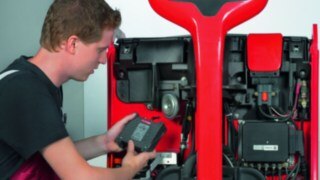
All connect: hardware components can be ordered with new vehicles ex work and also as spare part kit for retrofitting. Thus, existing and third-party vehicles can be integrated into the Linde fleet management.

All connect: hardware components can be ordered with new vehicles ex work and also as spare part kit for retrofitting. Thus, existing and third-party vehicles can be integrated into the Linde fleet management.
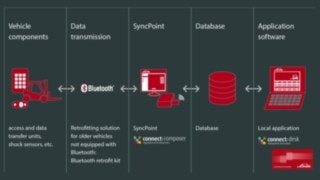
Most fleet managers prefer local solutions. With implementing connect:desk a reasonable but effective data communication infrastructure is set up on site: If a vehicle from approaches a SyncPoint – industry computers that form a network of synchronization points within the plant – the information is automatically retrieved and transmitted via Bluetooth to the local server. Commands and control parameters from connect:desk are transferred back to the forklift truck the same way.

Most fleet managers prefer local solutions. With implementing connect:desk a reasonable but effective data communication infrastructure is set up on site: If a vehicle from approaches a SyncPoint – industry computers that form a network of synchronization points within the plant – the information is automatically retrieved and transmitted via Bluetooth to the local server. Commands and control parameters from connect:desk are transferred back to the forklift truck the same way.
Every function enables additional applications
To date, the connect: product family includes four function groups: Access comprises access control via RFID chip or PIN – the basis for planned fleet usage. Data records hours of operation, crash detection and error code transmission - modules that help mainly to optimize service and maintenance and to avoid damage to the vehicles. The usage analysis module captures lifting, lowering and driving time data, as well as speed and further performance parameters and is part of the Analysis function group. These figures all provide information on the usage of the fleet: Are the right vehicles in use? Is the utilization rate optimal? How much energy is consumed? For now, the Tracking group initially includes the Indoor/Outdoor module. A sensor detects whether the vehicle is used in a hall or outside. Thus, e.g. the indoor speed can be automatically reduced and accidents avoided. Moreover, it is possible to define access restrictions for certain vehicles. Later this year, the modules vehicle localization and zone control will be introduced, which allow the control of vehicle functions even more accurately with regard to the place of use and the driver in order to minimize accidents and damage to the vehicle or buildings.
connect:desk – the data cockpit for administration, analysis and control
The local connect: desk application displays the entire available information broken down by the business organization, it assigns vehicles to drivers and thus facilitates the scheduling of vehicles. Here drivers are created, access rights for vehicles or vehicle groups assigned, speed limits set, and driver and vehicle documents stored digitally. A customizable dashboard shows the most important data for the user at a glance and automated messages remind them about upcoming maintenance or driver training. Moreover, detailed and interactive evaluations and reports can be created, exported and forwarded ad hoc or at defined intervals to enable analyses for fleet optimization and vehicle utilization. When clicking, for example, on data points in graphics, the software displays additional information about the vehicle, driver, or event.
The mobile solution – connect:portal
Alternatively, data such as operating hours or collisions can be transferred from the vehicles directly to the Linde cloud via the mobile communications network. Customers who do not want to install a local infrastructure at their premises can access this data anytime using any PC, tablet or smartphone with internet connection. Here again, many reporting and analysis functions are available, and the data can also be exported to other IT systems.
“Connectivity offers countless opportunities to simplify processes and automate procedures – even for in-house traffic. We are working on interlinking our vehicles even more closely with IT systems and users, and enabling them to communicate with buildings. In this way, we are more and more extending the scope of connect:’s functions,”explains Maik Manthey. “For this year the connect:Preshift app is on our agenda, which enables vehicle checks via smartphone at the start of a shift, and Wi-Fi as a second data transmission standard.”

